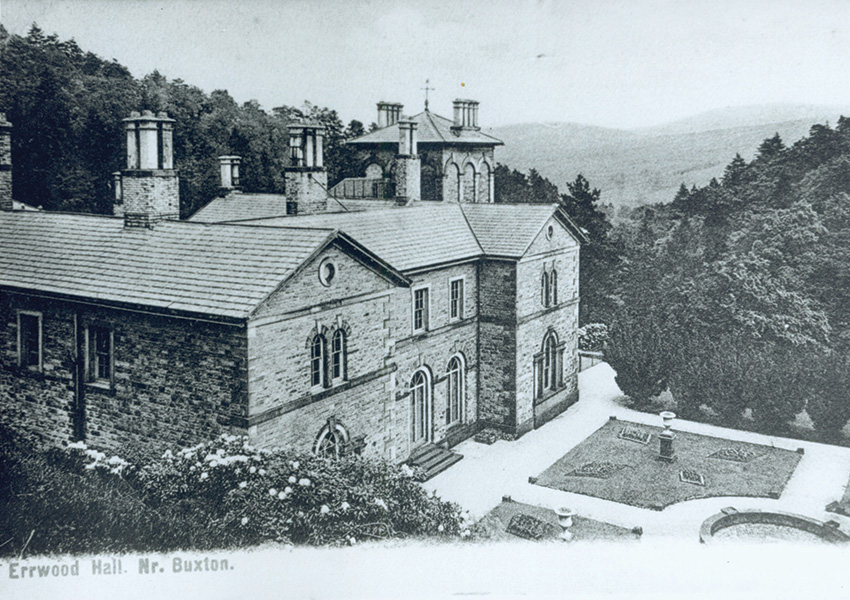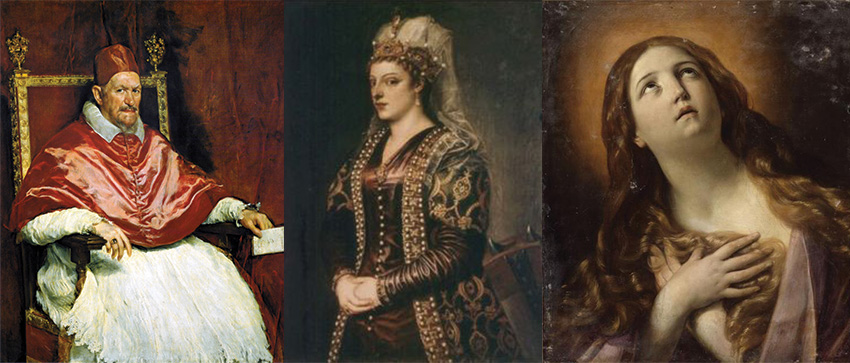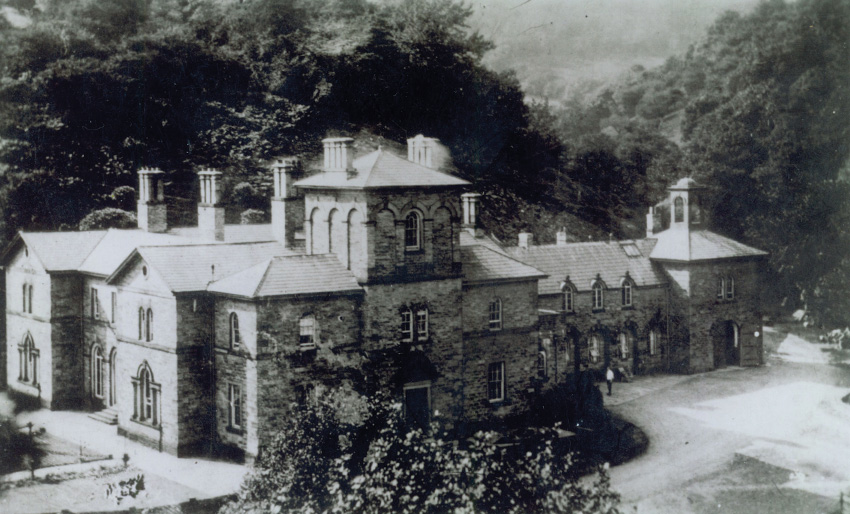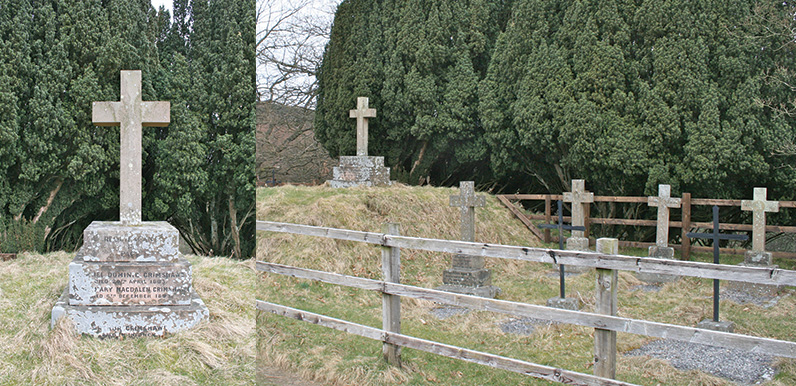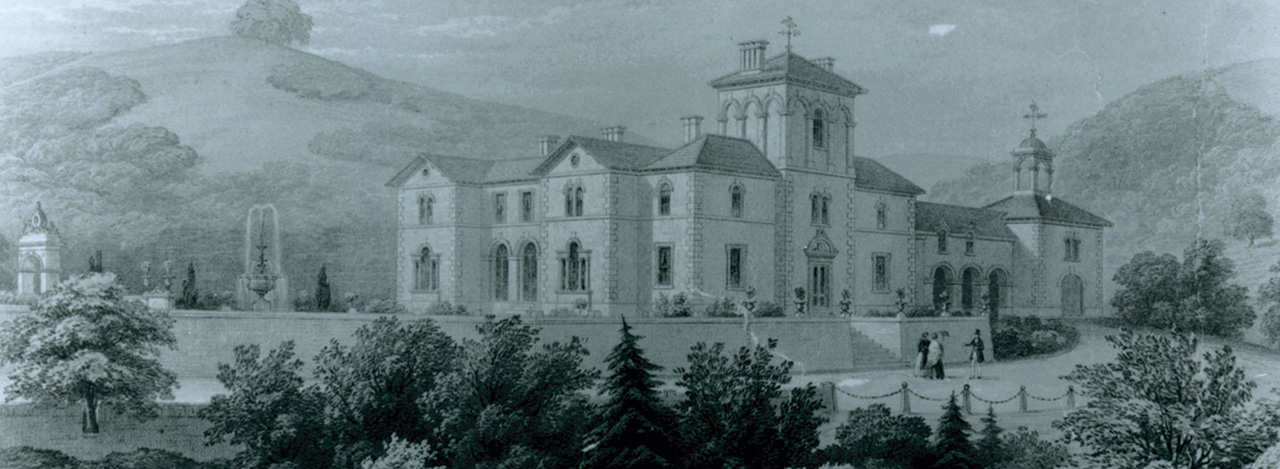
A Visit to Errwood Hall, near Buxton
By a reporter May 23rd 1883
Errwood Hall, for such is its name, is a modernised building of dressed stone, with rooms of considerable size and number. In the centre there is a noble tower, underneath which is the main entrance to the elegant structure, reached from the ground by a fine flight of steps.
On the right side of the Hall are fitted up the various offices required by the servants, and also the stables, coach house, and other outbuildings necssarv. On the left side is the lawn and the terraces. In the centre of the neatly laid out frontage is a very fine layer, with a fountain springing up from an artificially constructed basin.
A number of carefully laid out flower beds, with their gaily blooming flowers, contesting with the sombre hue of the green mossy rocks on the right side, and the variegated trees on the other, with the noble archway in front, make tip a very pleasing sight.
On the entrance arch to the terraces are the crest and monogram of the family inhabiting the hall, namely Samuel Grimshawe, Esq., J.P., a venerable gentleman, who, prior to his death, made this abode his country seat.
The terraces rise in easy ascents to the beautiful romantic walks on the high hill, situated upon a declivity of which the entire buildings rest, securely sheltered from the fierce winds which sweep over the heights around.
Internally this mansion is most magnificently furnished, not only with most of the modern luxuries which wealth can command, but also with many rare and costly works of art, the production of foreign continental lands, more especially Italy, whose holy city, magnificent Rome, has been brought under good contribution to provide some of the marvellous paintings, or splendid marble, which adorn the walls of this palatial home.
By the kindness of the benevolent owner we are able to give a few items respecting some of the most noteworthy rooms, and their appointments.
Attached to the hall, and in fact, forming part of the building, is a very handsome room, fitted up as a chapel, for the use of the family and servants, and the few inhabitants of the neighbouring farmsteads and cottages to celebrate divine service.
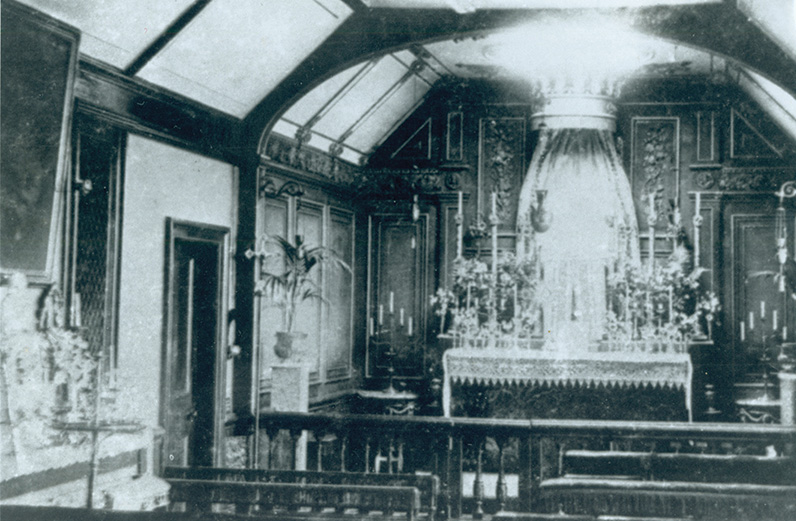
A rare photo taken inside Errwood Hall – of the family chapel which I understand was at the top of the three-storey tower.
The room is very comfortably furnished and well lighted; and has two altars, the largest of which has a neatly-formed chancel or communion attached to it for the use of the officiating priest and his attendants to stand and celebrate Mass or other services.
There is a beautifully constructed canopy over the altar, with its splendid cross and other things; when lighted by the numerous wax lights it has a splendid appearance. There are on the second altar some elaborate things useful for ornament or use in the services. Some splendidly executed figures of the Madonna, an altar piece, “Ecce Homo,” by Guido; Madonna of San Luca, and one by Simone Memmi, celebrated old masters. There is also an original portrait of the Blessed Benedict Joseph Labee, by Cavallucci, and some other oil paintings.
Both altars, and the entire fittings and furniture of this room, are worthy of the noble owners of the hall. And air of ease and elegance seems to be enjoyed, as well as a spirit of devotion seems to hover about the place.
Passing into the various staircases we find the walls adorned with extremely well executed and fresh looking medallions, and scenes in history depicted in exquisitely worked white Elgin and other marbles. The blue room and the drab room are, with a few others, mostly utilised as bed rooms, and are furnished with very artistic bedsteads, cabinets, and other appointments, with some elaborate tapestry or silken work.
The upstairs library which is superbly furnished, contains some very fine volumes, perhaps some of the oldest books extant. The reception room, leading from the floor of the building, is furnished in the must luxurious manner. Within a splendid frame are some remarkable fine photographs of one of the Queens of Spain and her daughters, presented to the Grimshaw family.
A splendid gilded gold framed state chair, with a seat and back of the finest embroidery, worked in a beautiful pattern, and a grand sofa, with embroidery and other elaborate sittings to match with the chair, are objects well worthy of notice.

These items from the 1930 auction catalogue show the style of furniture and furnishings in the Hall.
There is also a number of elaborately made stands and cabinets. A splendid chest of black ebony, with panels of tortoise shell, is well constructed with a number of drawers, and stands upon a gilded carved table. A fine ivory carving, a number of oil paintings, some old pottery, and a variety of elaborate ornaments, may also be seen in rich profusion.
The roof is also a work of art seldom noticed; it is flowered and figured, and laid out in a pattern carpet fashion, the various tints and shades of colour being visible at every point. The splendid sunshades of the windows also contrast favourably with the furniture.
The fire place and mantel shelf are also works of skill, the former being of elaborately printed porcelain pottery. No ordinary amount of skill seems to have been lavished in order to make everything contrast agreeably, and none but artists of the most skilful hands could have done the work; the same may be said of the decorations of all the rooms.
The large drawing-room has a splendid appearance, the brilliant colours of the showy flowers which adorn the ceiling, which is also elaborately wrought into a huge picture, forms a pleasing contrast in harmony with the rich fittings of the room.
In the centre of this noble apartment is a most conspicuous object, a very finely inlaid marble table, formed of hundreds of small pieces of variegated stones, placed in circles within circles, and beautifully polished upon its capacious surface. It is of the most exquisite workmanship, and standing upon an elegant support of grey stones, presents a truly magnificent appearance. It has been brought from Rome.
There are also some fine old china vases, some antique furniture, the seats, chairs, and ottomans being covered with crimson velvet gold braided, with the extremely well-fitted and rich damask curtains, and the large mirrors fitted between the three large windows, reaching from the ceiling to the floor, form an aspect not often seen in such places.
Some splendid oil paintings adorn the walls, and amongst these we may notice the following: In a gilded frame, and in old Spanish tapestry work, is a finely-executed picture of St. Francis from the collection of the Brazilian Minister in Rome; a fine portrait of Pope Innocent, by Velasquez (above left); portrait of “Catherine, Queen of Cyprus,” by H. Moro (centre); “St. Mary Magdalene, by Guido (right); “Justice and Peace,” by Battoni; marble statue of the Immaculate Conception (the woman shown with her foot on the serpent’s head), by Benzoni. Several other valuable works of art also grace the room.
The downstairs library is well worthy of notice, containing as it does some thousands of volumes of the rarest and most costly productions of the press. The roof is beautifully coloured and adorned with a splendid floral pattern in bright tints, with flowered corners, and a neat border to match; there is also emblazoned on the ceiling in panel fashion the arms and crest of the family, which is a splendid piece of decorative art.
Two of the most conspicuous objects are a fine portrait of a Spanish lady by Velasquez, and a most exquisitely worked marble bust of Pope Pins IX, by Bezoni; every feature in the face of His Holiness seems to have been drawn out with life-like effect.
The dining-room is also a spacious apartment, and besides being admirably furnished with a very capacious dining table and other furniture to match, has a splendidly adorned roof, and possesses some rare old oil paintings, amongst which are a portrait of one of the Leane family, by Michael Angelo Correggio; large landscape and sea piece by William Vandervile; portrait of Pope Gregory the Great by Titian; two landscapes, by Rosa de Tivoli; two views of Venice (Canaletto); Adoration of the Magi, by Pietro di Cortona. The Basso Relievi (to be seen) embrace admirable representations of various subjects, amongst which are The Triumph of Alexandra from Thorwaldsen; panathenaic procession, from the Elgin marbles; and others from Thorwaldsen and Flaxman are well worthy the admiration with which they are viewed.
The situation of the hall is one of the most romantic which could be selected, founded upon a space made in the declivity of a rising hill, amidst the most exquisite woodland scenery and quietly secluded; it is admirably fitted for a place of retirement from the busy scenes and anxieties of city life.
The views from the front of the building, and especially from the tower, are extremely grand. The bold bleak looking peaks of the Derbyshire hills, rising in lofty undulating heights far away in the distance, strike the eye with their varigated herbage or moss covered rocks.
The snugly ensconced farmsteads dotted here and there in the landscape, the cattle and sheep grazing quietly on the slopes, the wild moorland, and the shady dell besprinkled with the sombre hue of the holly and other evergreen bushes, give the mind a beautiful idea of country scenery in some of its natural aspects. The fine bracing air of this district is beneficially felt by the inhabitants of the valleys or mountain sides.
Above the hall is a very commanding height, at the summit of which is erected a small mortuary chapel, underneath which was deposited over 39 years ago, the mortal remains of an infant son of the Grimshawes. Recently, also, a servant at the hall, who died, was interred in a neatly fenced grave on the hill; and on May 1st Samuel Grimshawe, Esq., J.P.’s remains were laid to rest in the chapel there.
From this place the Cheshire hills rise in lofty grandeur, and stretch away as far as the eye can reach; the bleak moors present a wild, weird looking appearance. Miniature forests of trees, all stunted and broken as if by an east wind, are visible, and present themselves here and there, the green foliage of the holly and rhododendron relieving their forlorn appearance.
Resting in the peaceful valley at its foot are some neatly whitewashed cottages and farmsteads, for the use of the outdoor employees of the hall, all looking quite picturesque amidst their grand and striking surroundings.
Near the hall, and almost hidden amidst the romantic grounds are the streams forming the source of the River Goyt, which afterwards becomes the Mersey. The largest branch apparently rises in a valley, some little distance from Errwood, whilst two of the smaller streams descend from the right and left of the hall, and are spanned by rustic stone bridges leading from the shady walks.
These two are united before reaching the bottom of the carriage drive, and thence flow down a very picturesque dell to the Lodge Cottage, where the water unites itself with the lager stream mentioned, and then form a tolerably large brook, which expands as it is swollen by the numerous rills which flow into it.
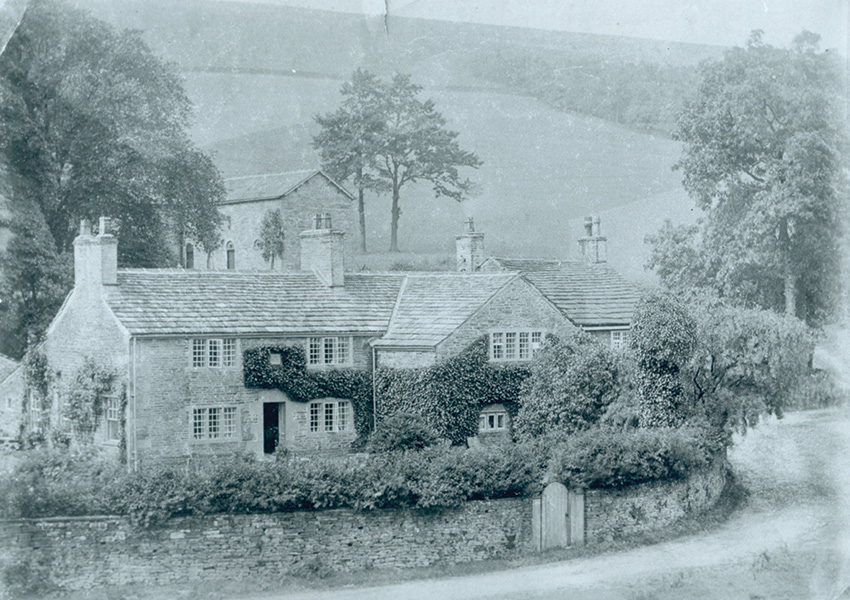
Gatehouse Cottage is at the end of the drive leading from Errwood Hall, so must be the ‘Lodge Cottage’ described here.
Fish abound in the clear pellucid waters, and may be seen from the banks disporting themselves, or lying quietly on the sand. The water descends in many places in gentle cascades over its rocky bed, except in flood time, when vast volumes sweep irresistibly down the gorges, and tumble with a roar into the deep fissures here and there along their course.
The Hall, nestling in its snug and almost inaccessible position, is approached from Whaley Bridge and Buxton by an excellent carriage road, which connects itself with the highway in Fernilee. The route is very pretty and varied scenes meet the eye.
From the Lodge, passing down an open field, it winds round a curve, and then by a shady copse past the Gunpowder Mills, which lie in the valley, and thence alternately into open field and wood, until it emerges near the Lodge Cottages, where it begins to ascend, by a gentle ascent, amid the fine grove of rhododendrons, holly, and other evergreen bushes (the former of which in the flowering season are very beautiful), by the pale green ferns and the grassy and mossy slopes, and the winding rivulets, and the most delightful, natural, and artificial scenery, until, on reaching a bend in the path, the noble pile bursts in full view like some fairy palace just dropped into the bosom of the evergreen surrounding.
Ultimately it is reached upon a broad plateau, which at once enables the hail to be seen in all its beauty. In summer, it is a pleasant resort for pleasure parties, the drive being very much enjoyed.
I’m not sure where this 1883 article describing Errwood Hall was published. It’s taken from Gerald Hancock’s book, ‘Goyt Valley Romance’, which is sadly now out of print.
The reporter’s fawning description of this impressive Victorian country house paints an oppressively catholic interior, full of religious paintings, sculptures and iconography.
Samuel Grimshawe had converted to catholicism shortly after the death of his father. I can’t help thinking the two things must have been connected!
Click here to read about the auction of the Hall’s contents in 1930.
